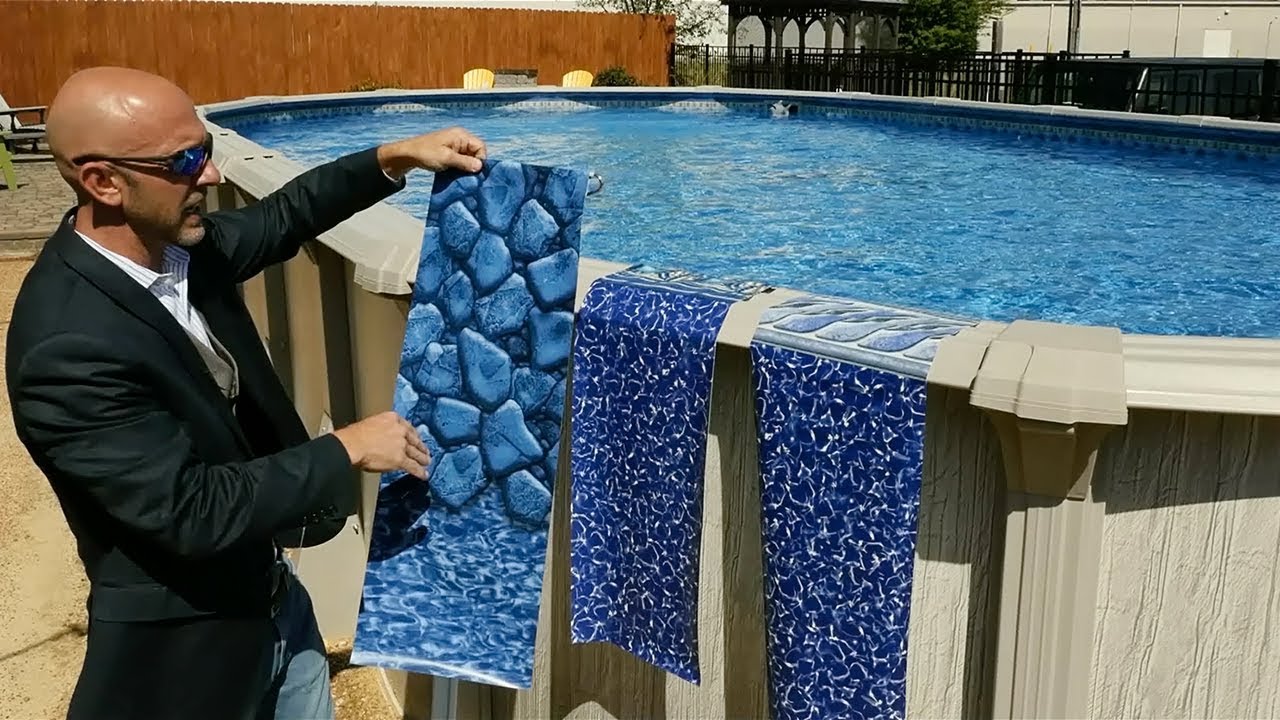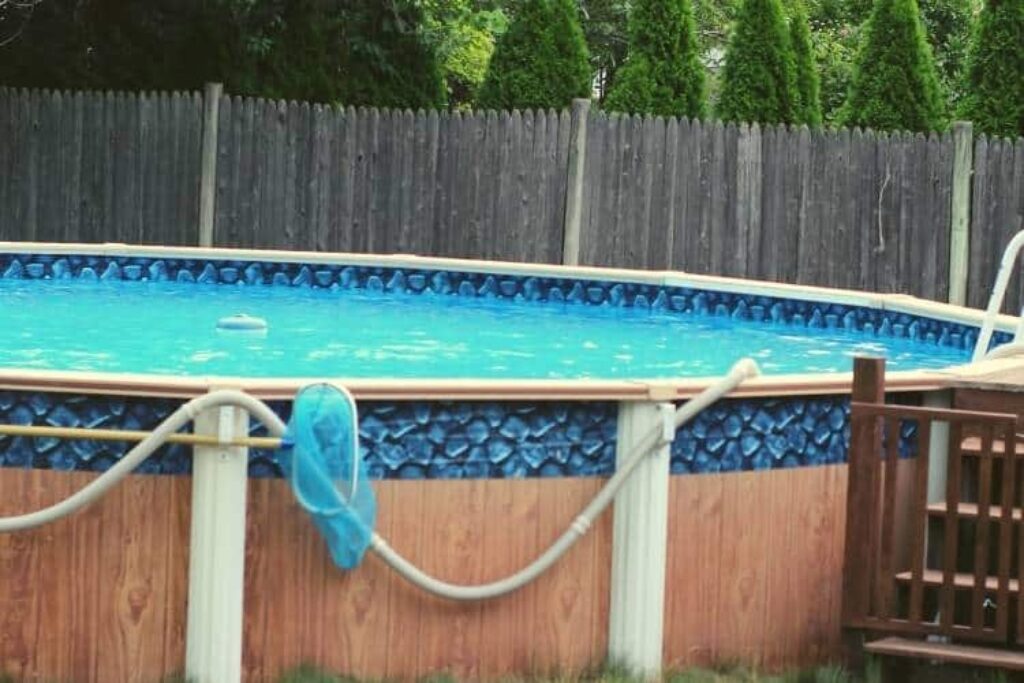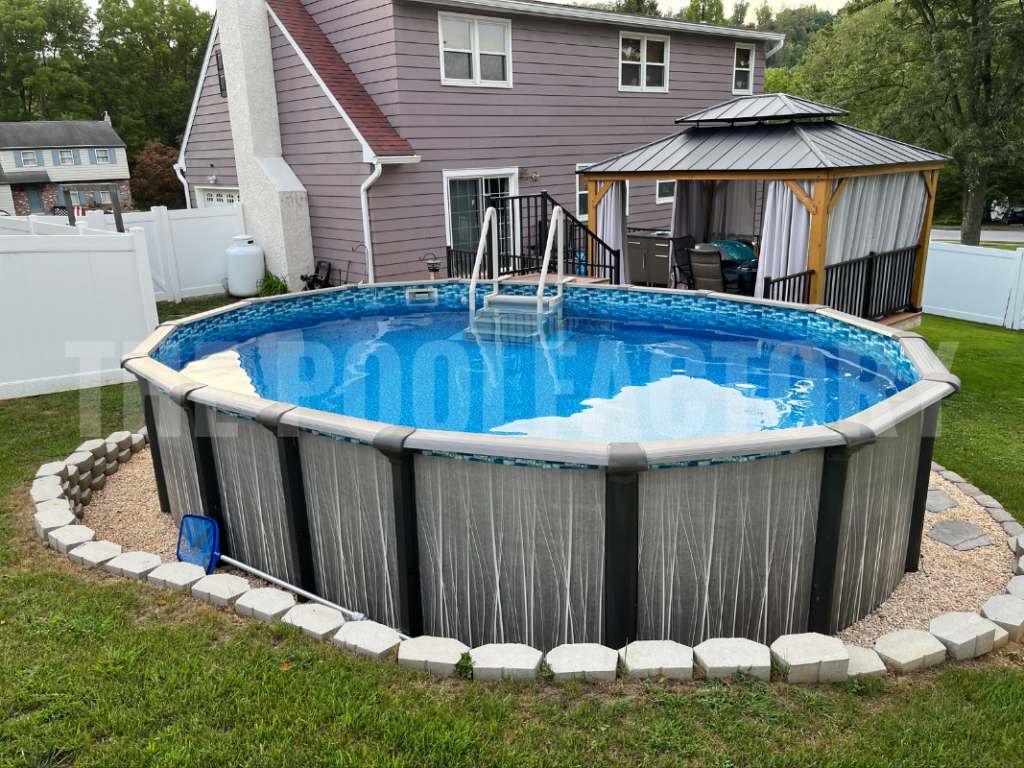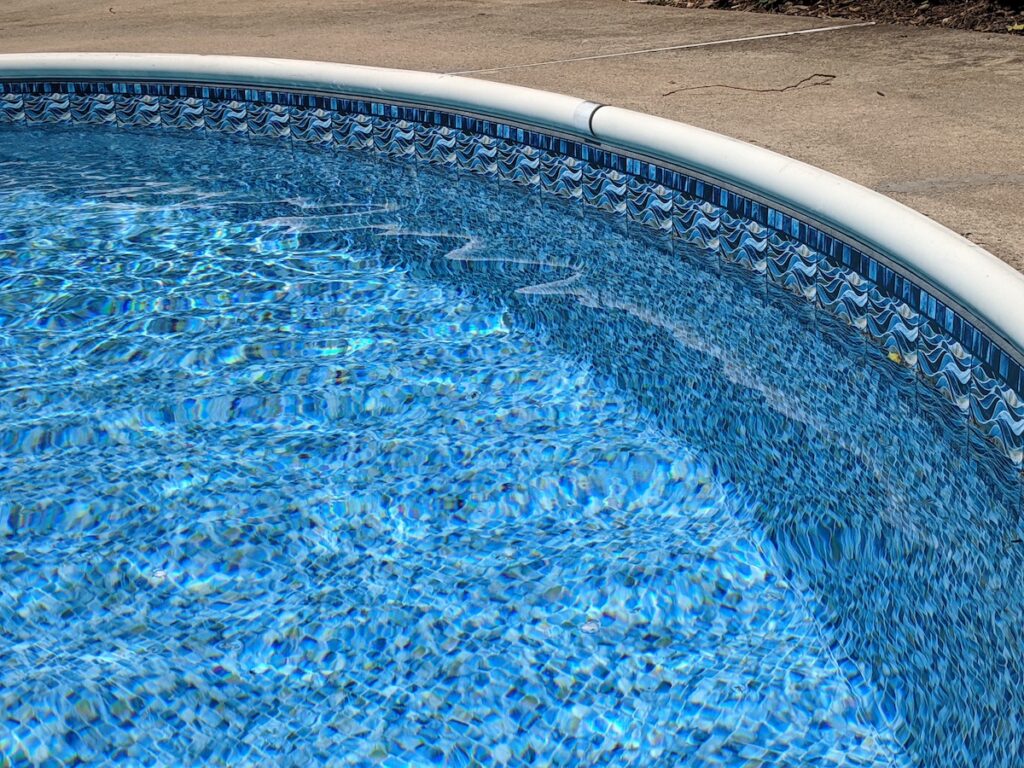So, you’ve got an above ground pool and you’re looking to get the perfect liner to make your pool shine. Well, look no further! In this article, we’ll guide you through the process of choosing the right liner for your above ground pool. Whether you want to add a splash of color or prefer a more neutral tone, we’ve got you covered. Get ready to dive into the world of pool liners and find the one that will transform your pool into a backyard oasis.
1. Types of Liners
When it comes to choosing the right liner for your above ground pool, there are several options to consider. Each type of liner comes with its own set of advantages and disadvantages, so it’s important to understand the differences before making a decision. Here are the five main types of liners commonly used for above ground pools:
1.1 Vinyl Liners
Vinyl liners are a popular choice for above ground pools due to their affordability and versatility. They are made from a durable vinyl material that is resistant to fading and tearing. Vinyl liners are available in a wide range of patterns and designs, allowing you to customize the look of your pool. They are also relatively easy to install and maintain.
1.2 Fiberglass Liners
Fiberglass liners offer a more durable and long-lasting option for above ground pools. They are constructed from a strong fiberglass material that is resistant to cracks and damage. Fiberglass liners are known for their smooth and sleek finish, which can enhance the overall aesthetic of your pool. However, they are typically more expensive than vinyl liners and require professional installation.
1.3 Tile Liners
Tile liners provide a luxurious and high-end look to above ground pools. They are made from ceramic or porcelain tiles that are individually placed on the pool walls and floor. Tile liners offer excellent durability and are resistant to fading and staining. They also provide endless customization options, as you can choose from a wide variety of tile patterns and designs. However, tile liners are the most expensive option and require regular maintenance to keep the grout clean and in good condition.
1.4 Rubber Liners
Rubber liners, also known as EPDM liners, are a more eco-friendly choice for above ground pools. They are made from a synthetic rubber material that is flexible and resistant to UV rays and chemicals. Rubber liners are highly durable and can withstand extreme temperatures without cracking or fading. They are also relatively easy to install and maintain. However, rubber liners have limited design options compared to other types of liners.
1.5 PVC Liners
PVC liners, also referred to as polyvinyl chloride liners, provide a combination of durability and affordability. They are made from a strong PVC material that is resistant to fading, tearing, and staining. PVC liners come in a variety of patterns and designs, allowing you to choose the one that best suits your style preferences. They are relatively easy to install and maintain, making them a popular choice among pool owners.
2. Factors to Consider
When choosing a liner for your above ground pool, there are several factors you should take into consideration. These factors will help you determine which type of liner is best suited for your specific needs. Here are the key factors to consider:
2.1 Pool Size and Shape
The size and shape of your above ground pool will play a significant role in determining the type of liner that is compatible. Some liners are better suited for standard pool sizes, while others can be customized to fit any shape or size. It’s important to measure your pool accurately and consult with a professional to ensure you choose a liner that fits perfectly.
2.2 Durability
Durability is another crucial factor to consider when selecting a liner for your above ground pool. Different liners have varying levels of durability, and it’s important to choose one that can withstand the wear and tear of regular use. Factors such as liner thickness, tear and impact resistance, as well as UV and chemical resistance, all contribute to the overall durability of the liner.
2.3 Cost
Cost is often a significant factor in decision-making when it comes to pool liners. The initial cost of the liner, as well as the long-term maintenance costs, should be taken into account. While some liners may have a higher upfront cost, they may also offer greater durability and a longer lifespan, potentially saving you money in the long run.
2.4 Maintenance
Consider the level of maintenance required for each type of liner. Some liners may require regular cleaning and upkeep, while others are relatively low-maintenance. Understanding the maintenance requirements will help you choose a liner that fits your lifestyle and time commitment.
2.5 Aesthetics
The overall look and aesthetic appeal of your above ground pool are important factors to consider. Each type of liner offers different patterns, designs, and customization options. Consider the style and ambiance you want to create with your pool and choose a liner that complements your vision.
This image is property of thepoolpassion.com.
3. Vinyl Liners
Of all the types of liners available for above ground pools, vinyl liners are the most popular choice. They offer several advantages, but they also have some drawbacks to consider.
3.1 Advantages
One of the main advantages of vinyl liners is their affordability. Compared to other options, vinyl liners are relatively inexpensive, making them a cost-effective choice for many pool owners. Additionally, vinyl liners come in a wide variety of patterns and designs, allowing you to customize the look of your pool to your liking. They also provide a smooth and comfortable surface for swimmers and are resistant to algae growth.
3.2 Disadvantages
While vinyl liners offer many benefits, they do have some disadvantages. One of the main drawbacks is their susceptibility to punctures and tears. Sharp objects or rough play can potentially damage the liner, requiring repairs or replacement. Additionally, vinyl liners have a limited lifespan compared to other types of liners and may fade over time due to exposure to sunlight and pool chemicals.
3.3 Thickness Options
Vinyl liners come in various thickness options, typically ranging from 20 mil to 30 mil. The thicker the liner, the more durable and long-lasting it will be. Thicker liners also offer better resistance to punctures and tears, making them a suitable choice for families with active kids or pets.
3.4 Patterns and Designs
One of the standout features of vinyl liners is the wide range of patterns and designs available. Whether you prefer a classic look or a more vibrant and contemporary design, there is a vinyl liner to match your style. From mosaic tiles to realistic rock formations, the options are virtually endless, allowing you to create a unique and visually appealing pool.
4. Fiberglass Liners
Fiberglass liners offer a durable and long-lasting option for above ground pools. They come with their own set of advantages and disadvantages that should be considered before making a decision.
4.1 Advantages
One of the significant advantages of fiberglass liners is their superior durability and resistance to cracking or damage. The fiberglass material is strong and flexible, allowing it to withstand the pressures of shifting soil and freezing temperatures. Fiberglass liners also provide a smooth and sleek finish, giving your pool a high-end and luxurious look. Another benefit is that they require minimal maintenance, as they are resistant to algae growth and staining.
4.2 Disadvantages
Despite their many advantages, fiberglass liners do have some drawbacks. One of the main disadvantages is the high initial cost. Fiberglass liners are generally more expensive than other options, often requiring professional installation, which adds to the overall expense. Additionally, the customization options for fiberglass liners are more limited compared to other types of liners, as they come in predetermined shapes and sizes.
4.3 Installation Process
Installing a fiberglass liner requires professional expertise, as it involves specific techniques and equipment. The process typically involves excavating the pool area, preparing the ground, and then carefully placing the fiberglass liner into position. It is essential to hire experienced installers to ensure the liner is properly fitted and sealed.
4.4 Lifespan
Fiberglass liners are known for their longevity and can last for several decades with proper care. However, it is important to note that the lifespan of a fiberglass liner can be affected by factors such as water chemistry, UV exposure, and extreme weather conditions. Regular maintenance and proper pool care can help extend the lifespan of a fiberglass liner.
This image is property of i.ytimg.com.
5. Tile Liners
For those seeking a high-end and luxurious look for their above ground pool, tile liners can be an excellent option. However, it is crucial to consider both the advantages and disadvantages before deciding if they are the right choice for you.
5.1 Advantages
One of the primary advantages of tile liners is their aesthetic appeal. Ceramic or porcelain tiles offer a timeless and sophisticated look, adding elegance to your pool. Tile liners can be customized in terms of color, size, and design, allowing you to create a unique and stunning pool that reflects your personal style. Another advantage is their durability since tiles are resistant to fading and staining. Additionally, if any tiles get damaged, they can be individually replaced.
5.2 Disadvantages
The main disadvantage of tile liners is their high cost. Tile liners are typically more expensive than other options due to the materials used and the labor-intensive installation process. They also require regular maintenance, as the grout between the tiles can accumulate dirt and require cleaning. Additionally, tile liners can be more susceptible to cracking or chipping compared to other types of liners if the pool experiences shifting soil or freeze-thaw cycles.
5.3 Customization Options
One of the standout features of tile liners is the ability to customize every aspect of their design. From choosing the tile materials and colors to creating intricate mosaic patterns, you have complete control over the look of your pool. This level of customization allows you to create a unique and visually stunning pool that perfectly suits your style preferences.
5.4 Maintenance
Tile liners require regular maintenance to keep them looking their best. The grout between the tiles can accumulate dirt, algae, and other debris over time, requiring cleaning and potential regrouting. Regular brushing and cleaning with pool-safe cleaning products are necessary to maintain the cleanliness and appearance of the tiles. Proper care will ensure that your tile liner continues to look beautiful and well-maintained for years to come.
6. Rubber Liners
When it comes to eco-friendly options for above ground pool liners, rubber liners, also known as EPDM liners, are worth considering. They offer unique advantages and disadvantages that should be taken into account.
6.1 Advantages
One of the main advantages of rubber liners is their environmental friendliness. Rubber liners are made from a synthetic rubber material, typically EPDM (ethylene propylene diene monomer), which is designed to be UV resistant and chemical resistant. This makes rubber liners a great eco-friendly option for those looking to reduce their environmental impact. Rubber liners are also highly durable and can withstand extreme temperatures without cracking or fading. They are relatively easy to install and maintain, making them an attractive choice for many pool owners.
6.2 Disadvantages
One of the main disadvantages of rubber liners is the limited design options available. Compared to other types of liners, rubber liners have a more limited range of patterns and designs to choose from. While they may not offer the same level of customization as some other liners, the natural rubber appearance can still provide an appealing, natural look to your pool. Rubber liners are generally more expensive than vinyl liners but can be less expensive than other options such as tile or fiberglass.
6.3 Environmental Considerations
For eco-conscious pool owners, rubber liners offer a sustainable and environmentally friendly choice. Rubber liners are made from synthetic rubber materials that are designed to be resistant to UV rays and chemicals. By choosing a rubber liner, you can reduce your environmental impact and enjoy your pool with peace of mind.
6.4 Longevity
Rubber liners are known for their longevity and can last for many years with proper care and maintenance. The durable synthetic rubber material is resistant to cracking, fading, and damage caused by UV rays and pool chemicals. Regular maintenance and proper pool care can help extend the lifespan of a rubber liner, ensuring that it remains in excellent condition for years to come.
This image is property of blog.thepoolfactory.com.
7. PVC Liners
PVC liners, also known as polyvinyl chloride liners, are a popular choice for above ground pools. They offer a combination of durability, affordability, and customization options. Here are the advantages and disadvantages of PVC liners to consider:
7.1 Advantages
One of the primary advantages of PVC liners is their durability. They are made from a strong PVC material that is resistant to fading, tearing, and staining. PVC liners are designed to withstand the daily wear and tear of pool use, making them a reliable choice for families with active swimmers. Additionally, PVC liners are relatively easy to install and maintain, saving you time and effort in the long run.
7.2 Disadvantages
Despite their many advantages, PVC liners do have some disadvantages. One potential drawback is their limited design options compared to other types of liners. While PVC liners come in a variety of patterns and designs, the range may be more restricted compared to vinyl or tile liners. Additionally, the initial cost of a PVC liner may be slightly higher than a vinyl liner, but it can be more affordable than other options such as fiberglass or tile.
7.3 Installation Process
Installing a PVC liner is a straightforward process that can typically be done by pool owners themselves. The liner is simply laid out on top of the pool floor and walls and secured in place. However, if you’re not comfortable with DIY installation, it is recommended to hire a professional to ensure it is properly fitted and sealed. Proper installation is crucial to ensure the longevity and effectiveness of the liner.
7.4 Chemical Resistance
One of the standout features of PVC liners is their resistance to chemicals. PVC materials are known for their chemical resistance, making them suitable for pools that require regular chemical treatments to maintain water balance and cleanliness. PVC liners can withstand exposure to chlorine and other pool chemicals without deteriorating, ensuring that your pool remains in excellent condition.
8. Pool Size and Shape
The size and shape of your above ground pool will play a significant role in determining the appropriate liner. Here are some factors to consider when it comes to pool size and shape:
8.1 Standard Pool Sizes
Above ground pools typically come in standard sizes, ranging from small round pools to larger oval or rectangular pools. It’s essential to measure your pool accurately to determine the required liner size. Standard sizes are typically easier to find and more cost-effective, as they are mass-produced. However, if your pool does not fall into a standard size category, you may need to consider customization options or consult with a professional to find the right liner for your pool.
8.2 Custom Pool Shapes
If you have a custom-shaped above ground pool, customization options may be necessary to find a liner that fits perfectly. Certain liners, such as vinyl or rubber, can be cut and seamed together to accommodate unique pool shapes. However, it’s important to note that customization may increase the overall cost and installation complexity.
8.3 Liner Compatibility
When choosing a liner for your above ground pool, it is essential to ensure that the liner is compatible with your pool’s size and shape. Each liner type has specific compatibility requirements, so it’s crucial to consult with a professional or manufacturer to ensure a proper fit. Using an ill-fitted liner can lead to leaks, wrinkles, and potential damage, compromising the longevity and effectiveness of the liner.
This image is property of midstatepoolliners.com.
9. Durability
Durability is a crucial factor when choosing a liner for your above ground pool. Here are the key considerations when it comes to durability:
9.1 Liner Thickness
The thickness of the liner plays a significant role in its durability. Generally, thicker liners are more durable and resistant to punctures, tears, and damage caused by UV rays and pool chemicals. Thin liners are more susceptible to wear and tear and may need to be replaced more frequently. When selecting a liner, consider the durability requirements based on your pool usage, the presence of pets or children, and potential exposure to harsh weather conditions.
9.2 Tear and Impact Resistance
In addition to thickness, tear and impact resistance are important factors to consider. Liners that offer high tear resistance will be less likely to develop holes or tears due to normal wear and tear or accidental damage. Similarly, liners with good impact resistance can withstand the pressure exerted by swimmers and any objects that may come into contact with the liner.
9.3 UV and Chemical Resistance
UV and chemical resistance are crucial for a liner’s longevity and durability. Prolonged exposure to sunlight can cause fading, discoloration, and deterioration of the liner material. Similarly, pool chemicals such as chlorine can affect the integrity of the liner if it is not resistant to chemical damage. Ensure that the liner you choose is specifically designed to withstand UV rays and pool chemical exposure to ensure long-lasting performance.
10. Cost
Cost is often a significant consideration when choosing a liner for your above ground pool. Here are the main cost-related factors to consider:
10.1 Initial Cost
The initial cost of the liner includes the purchase price as well as any installation costs. Some liners, such as vinyl, rubber, and PVC, tend to have lower initial costs compared to options like fiberglass or tile. However, it’s important to consider the long-term value as well, as cheaper liners may require more frequent replacements or repairs, which can add to the overall cost over time.
10.2 Maintenance Cost
The maintenance cost of a liner should also be factored into the decision-making process. Some liners may require more frequent cleaning, sealing, or repairs, which can increase ongoing maintenance costs. Consider the long-term maintenance requirements and associated costs to understand the total cost of ownership.
10.3 Lifespan
The lifespan of a liner is an important consideration when assessing its cost. Liners with longer lifespans may have a higher initial cost but can provide better value over time. Consider factors such as material durability, warranty coverage, and maintenance requirements to determine which liner offers the best balance of initial cost and lifespan.
In conclusion, choosing the right liner for your above ground pool is a decision that should consider factors such as pool size and shape, durability, cost, maintenance, and aesthetics. Vinyl liners offer versatility and affordability, while fiberglass linings provide durability and a sleek finish. Tile liners offer a high-end look and customization options, while rubber liners offer eco-friendliness and longevity. PVC liners combine durability and affordability. When choosing a liner, it is crucial to consider the size and shape of your pool, as well as the durability, cost, and maintenance requirements. By carefully considering these factors, you can select the perfect liner that meets your needs and enhances your above ground pool experience.









